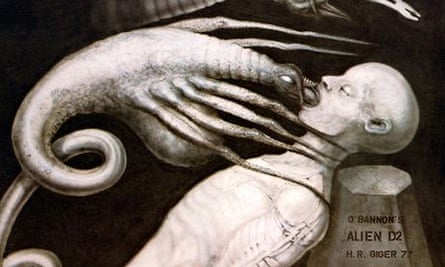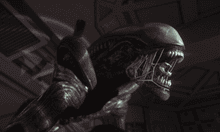HR Giger, whose "biomechanical" artwork lent Ridley Scott's film Alien much of its terror, has died aged 74.
A spokesperson from his gallery in Switzerland confirmed the news. According to the Swiss press, he died from injuries sustained in a fall on stairs.
Born in 1940 in Chur, Switzerland, Giger studied architecture and industrial design in Zurich, before beginning a successful career in art and interior design from the mid-1960s onwards. Beginning with ink and oil paintings, he graduated to using an airbrush, which helped articulate his vivid, often disturbing style, characterised by dark sexuality and cyberpunk energy.
His painting Necronom IV, depicting a creature with a human torso and grotesquely phallic skull, was seen by Ridley Scott who used it as the inspiration for his sci-fi horror film Alien. Giger received an Academy Award as part of the visual effects team for the film; as well as the chest-bursting "xenomorph" that is the film's central focus, Giger's designs also inspired the derelict spacecraft, the unfurling alien eggs, and the masked 'Space Jockey' gunner discovered on it. The film's producer Gordon Carroll described the artist's work as "sick", but Scott was bowled over, later saying: "I'd never been so certain about anything in all my life."
On hearing the news of his death, Scott said: "I am very saddened to hear of Giger's passing. I think back on how committed and passionate he was, and then consequently, all the security we built up around his 'lock up' studios at Shepperton. I was the only one allowed the honour of going in, and I absolutely enjoyed every hour I spent with him there. He was a real artist and great eccentric, a true original, but above all, he was a really nice man. He will be missed."
The designs continued to be used in the subsequent Alien sequels, and in 2012 Giger contributed murals for Scott's most recent film in the saga, Prometheus; but he was left off the credits for Alien: Resurrection, prompting an angry letter to the studio that ended: "As for those responsible for this conspiracy: All I can wish them is an Alien breeding inside their chests."

In 1975 he was hired by fellow cult visionary Alexander Jodorowsky to design the world for his film adaptation of the science fiction novel Dune, which at one point was slated to star Salvador Dali. In the end, the film was directed by David Lynch with just a fraction of Giger's designs. "My planet was ruled by evil," Giger said of his Dune design, "a place where black magic was practiced, aggressions were let loose, and intemperance and perversion were the order of the day. Just the place for me, in fact." In a 2009 interview with Vice he credited Samuel Beckett, HP Lovecraft, crime writer Edgar Wallace, and his childhood fears amid World War II as key inspirations.
In the wake of Alien's success he became a go-to designer for repellent yet sensual imagery, with his work also used in horror sequel Poltergeist II and erotic sci-fi thriller Species, though he later said that "I was only pleased with Alien, and with the other [films] I was not very happy with." He designed a radically reimagined Batmobile for Batman Forever, shaped like a crooked X, but it was passed over for a more conservative design.
Giger also designed iconic and controversial record sleeves: on Debbie Harry's Koo Koo the singer appears with spears cutting through her face, while the poster insert for the Dead Kennedys' Frankenchrist prompted an obscenity trial. He also designed the cover for Emerson Lake & Palmer's 1973 album Brain Salad Surgery.
He later created "Giger Bars" in Switzerland which used his designs for their interiors – he disowned another bar in Japan after they failed to properly realise his designs. In 1998 he opened the HR Giger Museum in Chateau St. Germain, Switzerland, which hosts the largest collection of his work alongside his own private art collection, featuring Dali, Ernst Fuchs and Bruno Weber amongst others.










Comments (…)
Sign in or create your Guardian account to join the discussion